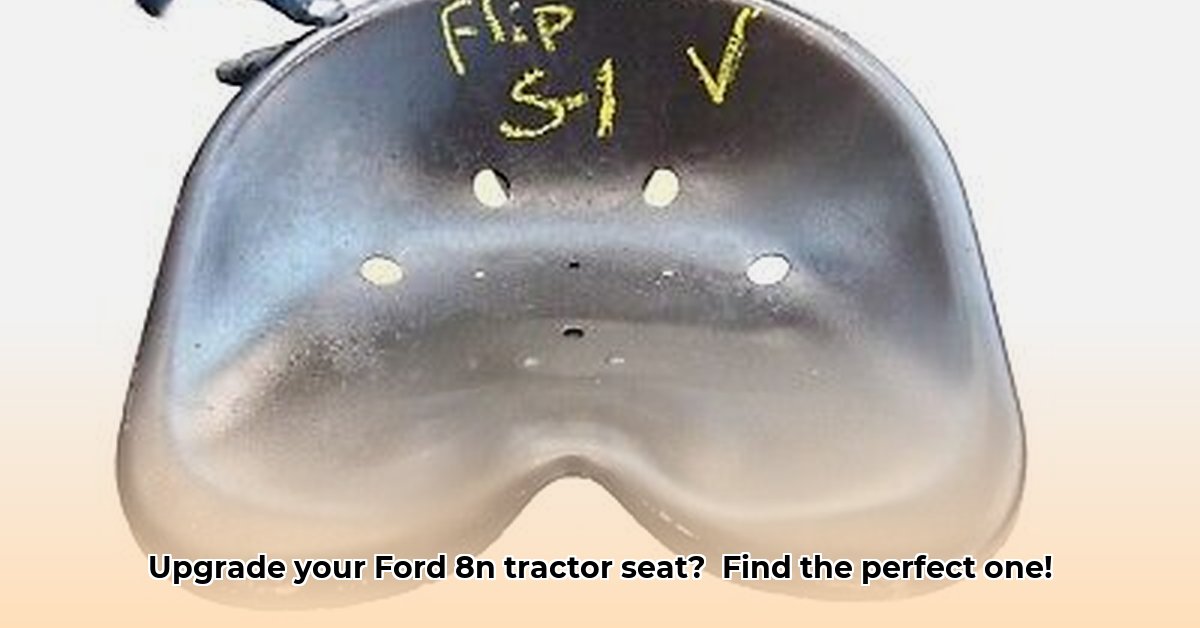
Choosing the Right Ford 8N Tractor Seat
Finding the right seat for your Ford 8N tractor can be surprisingly complex. This section will guide you through the key considerations to ensure a comfortable and safe driving experience. Are you ready to transform your tractor rides? For more advanced seating options, check out these air ride seats.
Fixed vs. Flip-Up Seats: A Comparison
The first decision involves choosing between a fixed seat and a flip-up seat. A fixed seat (permanently attached) offers simplicity and robust durability. It’s the most common type for the 8N, providing a stable and uncomplicated seating arrangement. A flip-up seat, however, allows for convenient access to the tractor's controls and the engine, making maintenance and adjustment easier. This flexibility comes with a slightly increased complexity of installation and maintenance; they might be susceptible to wear and tear on the hinges over time.
Here's a quick summary of each:
| Feature | Fixed Seat | Flip-Up Seat |
|---|---|---|
| Simplicity | Easy to install and maintain | More complex installation |
| Versatility | Limited | Easier access to tractor |
| Durability | Generally very durable | Potential hinge wear |
| Cost | Typically less expensive | Often slightly more expensive |
Compatibility: Ensuring a Perfect Fit
One of the most critical factors is compatibility. Ford 8N tractors were produced over several years, with slight variations in design impacting seat mounting. Improper seat selection could lead to discomfort or even safety hazards. To avoid this, always verify your tractor's year and model number; this information will be essential in finding the perfectly matched seat.
Compatibility Guide (Consult Your Owner's Manual for Precise Specifications):
| Year Range | Common Seat Types | Important Considerations |
|---|---|---|
| 1947-1952 | Primarily fixed; some flip-up | Spring width and mounting bracket variations exist. |
| Late-production | Potentially different mounting | Precise measurements are crucial for accurate fitting. |
Understanding Your Seat's Components
A tractor seat is more than just a cushion; it's a system of interworking parts. Understanding these elements helps diagnose issues and facilitates informed purchasing decisions. Key components include:
- Springs: These provide support and cushioning. Spring width varies, affecting compatibility.
- Cushion: The padded seating surface, available in various materials (vinyl, fabric) and colors.
- Hinges (flip-up seats only): Allow the seat to pivot upwards. These are prone to wear and tear.
- Mounting Hardware: Bolts, brackets, and other metal components that secure the seat.
OEM parts typically offer superior quality and guaranteed fit, though aftermarket choices are available, potentially at a lower cost. However, prioritize quality to ensure longevity and safety.
Color and Material Options: Personalizing Your Tractor
Adding a personal touch is possible! Choose between the durability of vinyl (easy cleaning) and the comfort of fabric. Original colors may be harder to find, but some suppliers specialize in reproducing vintage color schemes.
Sourcing Your Replacement Seat: Trusted Suppliers
Several avenues exist for finding replacement seats. Online marketplaces offer extensive selection and user reviews but lack in-person expertise. Local agricultural suppliers or classic tractor specialists offer a more personalized experience and often stock hard-to-find OEM parts. Thoroughly research and read reviews before committing to any purchase.
Installing Your Ford 8N Tractor Seat: A Step-by-Step Guide
This detailed guide provides a clear approach to installing your new tractor seat, ensuring both safety and efficiency. Remember, a helper can simplify this process significantly!
Tools Required (Illustrative Image):
- Wrench(es) (appropriate sizes)
- Screwdrivers (Phillips and flathead)
- Pliers
- Spring compressor (optional, but recommended for easier spring compression)
Step-by-Step Installation:
- Preparation: Take photos of the old seat's attachment points before removal. This serves as a crucial visual aid during the installation of the new seat.
- Removal: Carefully detach the old seat, noting the order and method of attachment for each component. Avoid damaging the existing mounting points.
- Inspection: Examine the mounting points on the tractor's frame for any damage or wear. Repair or replace any parts as needed before proceeding.
- New Seat Preparation: Inspect the new seat for all components and minor preassembly of loosely attached hardware.
- Attachment: Align the new seat with its mounting points. Use your pre-installation photos to guide you. Securely attach the seat, ensuring proper alignment.
- Test Fit: Before fully tightening the fasteners, test the seat’s functionality. Verify that it moves smoothly and there are no hindrances.
- Final Tightening: Once satisfied with the fit, securely tighten all bolts and nuts to the recommended torque specifications.
Troubleshooting Tip: If spring compression proves challenging, a spring compressor is highly recommended. Always prioritize safety.
Maintaining Your Ford 8N Tractor Seat: Prolonging Its Life
Regular maintenance prevents costly repairs and ensures your seat's longevity.
- Cleaning: Regularly wipe down the seat with a damp cloth to remove dirt and debris. Use mild soap as needed, but make sure it dries thoroughly afterward.
- Lubrication (as needed): Apply lubricant to any moving parts (hinges, etc.) to prevent squeaking and corrosion.
- Inspection: Periodically inspect the seat for signs of wear and tear. Address any issues promptly to prevent further damage.
By following these simple steps, your Ford 8N tractor seat will serve you reliably for years to come, enhancing both comfort and the overall lifespan of your equipment. Remember that regular maintenance will pay off in the long run.